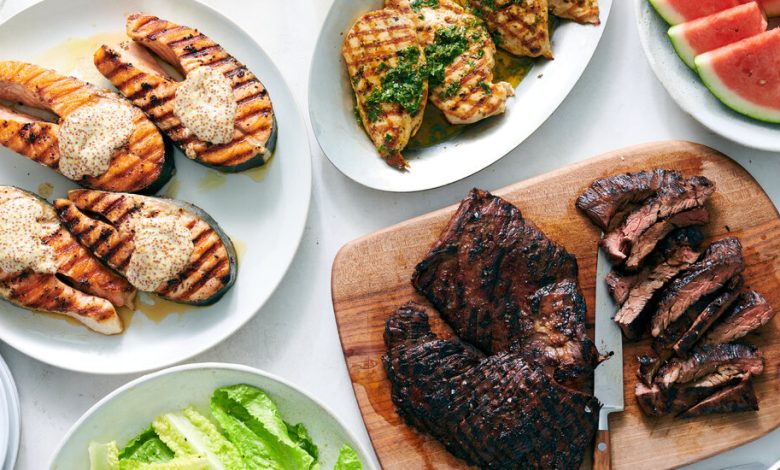5 Dishes Everyone Should Know How to Grill

Grilling may be the world’s oldest, most universal cooking method, but that doesn’t guarantee automatic success. Just ask the person who routinely burns the burgers or whose fish always sticks to the grate.
Suppose you’re a newcomer to the world of grilling or you just want a refresher. You don’t need to start with the thermodynamics of fire, the physics of fuels, the architecture of grills.
Focus instead on the basics and a handful of dishes to put into your summer rotation: a tender juicy steak; grilled chicken breast that actually tastes interesting; pork chops that evoke the spice and smoky flavors of your favorite barbecue joint; juicy burgers safely cooked; and fish that easily release from the grate.
There are five methods of live fire cooking: direct grilling, indirect, smoking, spit-roasting and on the embers, but direct grilling is the most universal. This means cooking tender, small or thin foods, like steaks or chops, directly over a hot fire. Don’t confuse it with barbecue, which uses low, slow heat away from the food to smoke things like Texas brisket and Carolina pork shoulder.
How to Start and Heat a Grill
When using a charcoal grill, light the coals in a chimney starter. You’ll have glowing embers in 15 to 20 minutes, no oily lighter fluid required. When using a gas grill, be sure to have the lid open when you light it to prevent a potentially dangerous buildup of propane. Use that waiting time to marinate your steaks or apply a rub to pork.
Build a tiered fire to control the heat: Rake the coals into a thicker layer in the back of the grill (your searing zone), a thinner layer in the center (your cooking zone), with no coals in the front third of the grill (your safety zone). On a gas grill, set one burner on high and one on medium, leaving the third burner off (your safety zone). If your grill lacks a third burner, use the warming rack as your safety zone. Control the heat — and the cooking — simply by moving the food between the hotter and cooler zones.
Begin With a Hot, Clean Grate
Clean hot grates with a stiff wire brush or wooden scraper (many people use the latter to avoid the slim but documented risk of ingesting a stray bristle). Oiling the grate minimizes sticking and gives you better grill marks. Use a paper towel folded into a tight pad, dipped in vegetable oil and drawn across the grate. Alternatively, use a chunk of bacon or steak fat, or a half onion impaled on a carving fork (a move that never fails to impress).
Cook Evenly and Accurately
Avoid overcrowding. Leave at least 1 inch between each piece of food for better heat circulation, and leave at least 25 percent of your grill grate free of food so you have room to maneuver and dodge flare-ups.
Use an instant-read meat thermometer to check for doneness. Insert it through the side of a burger or chicken breast, not through the top, to get an accurate reading.
Let the Meat Rest
Transfer your perfectly grilled steak or chop to a wire rack over a sheet pan (this keeps the bottom from getting soggy) or directly onto a platter or plates and let it rest for 1 minute before serving. This allows the meat to “relax” and the juices to redistribute, resulting in juicier, more tender meat.
If you know how to grill these five fail-proof dishes, you’ll have meals that look and taste great and make you look like a pro at the grill.
Recipe: Grilled Steak
Rich and beefy, skirt steak is relatively affordable and quick to grill. Marinating the steak, even briefly, allows it to soak up flavor while you light your grill.
Recipe: Grilled Pork Chops
Four seasonings are all it takes to make a classic barbecue rub, and you may have all of them at hand in your kitchen: salt, pepper, paprika and brown sugar. The rub gives these chops a hint of barbecue flavor without requiring a half-day’s worth of smoking.
Recipe: Inside-Out Cheeseburgers
For juicy burgers, choose a rich-flavored ground beef (ideally from the chuck or a mixture of chuck, short ribs and brisket) with a relatively high fat content (18 to 20 percent).
Recipe: Grilled Chicken Breasts
Chicken breasts are a blank canvas awaiting your culinary creativity. A simple olive oil, lemon and herb marinade adds flavor and keeps the bird moist — and doubles as the sauce.
Recipe: Grilled Salmon
To keep fish from sticking, choose thicker steaks and slather the fish with a mayonnaise-heavy sauce first. When fish first hits the grill, it will stick. The secret is to have the patience to let it grill for a few minutes without touching it, after which the proteins will release from the hot metal.
Follow New York Times Cooking on Instagram, Facebook, YouTube, TikTok and Pinterest. Get regular updates from New York Times Cooking, with recipe suggestions, cooking tips and shopping advice.





